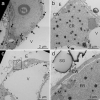Improved chemical fixation of lipid-secreting plant cells for transmission electron microscopy
- PMID: 35388424
- PMCID: PMC9340797
- DOI: 10.1093/jmicro/dfac018
Improved chemical fixation of lipid-secreting plant cells for transmission electron microscopy
Abstract
Cultured Lithospermum erythrorhizon cells were fixed with a new fixation method to visualize the metabolism of shikonin derivatives, the lipophilic naphthoquinone pigments in Boraginaceae. The new fixation method combined glutaraldehyde containing malachite green, imidazole-osmium and p-phenylenediamine treatments, and cells were then observed with a transmission electron microscope. The method prevented the extraction of lipids, including shikonin derivatives, and improved the visualization of subcellular structures, especially the membrane system, when compared with that of conventional fixation. The improved quality of the transmission electron micrographs is because malachite green ionically binds to the plasma membrane, organelles and lipids and acts as a mordant for electron staining with osmium tetroxide. Imidazole promotes the reaction of osmium tetroxide, leading to enhanced electron staining. p-Phenylenediamine reduces osmium tetroxide bound to cellular materials and increases the electron density. This protocol requires only three additional reagents over conventional chemical fixation using glutaraldehyde and osmium tetroxide.
Keywords: Lithospermum erythrorhizon; p-phenylenediamine; imidazole; malachite green; shikonin; transmission electron microscopy.
© The Author(s) 2022. Published by Oxford University Press on behalf of The Japanese Society of Microscopy.
Figures









References
-
- Hussein R A, El-Anssary A A (2019) Plants secondary metabolites: the key drivers of the pharmacological actions of medicinal plants. In: Builders P (ed.), Herbal Medicine, pp 11–30 (IntechOpen, Rijeka; ).doi: 10.5772/intechopen.76139. - DOI
-
- Guo C, He J, Song X, Tan L, Wang M, Jiang P, Li Y, Cao Z, and Peng C (2019) Pharmacological properties and derivatives of shikonin—a review in recent years. Pharmacol. Res. 149: 104463. - PubMed
-
- Tabata M, Mizukami H, Hiraoka N, and Konoshima M (1974) Pigment formation in callus cultures of Lithospermum erythrorhizon. Phytochem 13: 927–932.
-
- Shimomura K, Sudo H, Saga H, and Kamada H (1991) Shikonin production and secretion by hairy root cultures of Lithospermum erythrorhizon. Plant Cell Rep. 10: 282–285. - PubMed

